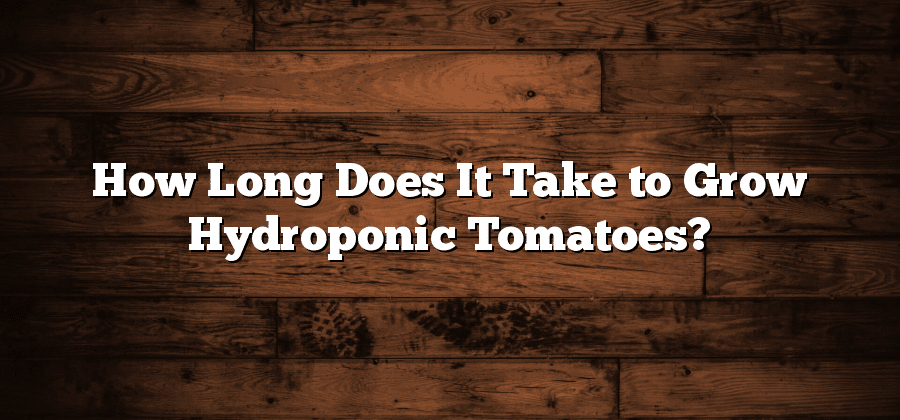The Growth Stages of Hydroponic Tomatoes
The growth stages of hydroponic tomatoes can be divided into several key phases. The first stage is the seedling phase, which starts with the germination of the seeds and lasts for about 2-3 weeks. During this stage, the seedlings develop their first set of true leaves and establish a strong root system.
After the seedling phase, the second stage is the vegetative growth phase. This is when the tomato plants begin to grow rapidly, producing new leaves and stems. It is important to provide the plants with optimal nutrient solutions during this phase to promote healthy growth. The vegetative growth phase can last for several weeks or even months, depending on the variety and environmental conditions. Once the plants have reached the desired size, they will transition into the next stage, which is the flowering and fruiting phase.
Factors Affecting the Growth Rate of Hydroponic Tomatoes
Hydroponic tomatoes have become a popular choice for home gardeners and commercial growers alike. The controlled environment of hydroponics enables the growth of healthy and robust tomato plants, but there are several factors that can affect their growth rate. Understanding these factors is crucial in optimizing the yield and quality of hydroponic tomatoes.
One essential factor that affects the growth rate of hydroponic tomatoes is the nutrition provided to the plants. Since hydroponic systems rely on nutrient solutions, it is important to maintain the right balance of essential elements. Tomatoes require a mixture of macronutrients like nitrogen, phosphorus, and potassium, as well as micronutrients like iron, manganese, and zinc. Imbalances in the nutrient solution can lead to deficiencies or toxicities that hinder the growth of tomato plants. Monitoring and adjusting the nutrient levels regularly is vital for healthy plant development.
Another factor that influences the growth rate of hydroponic tomatoes is the oxygenation of the root zone. In hydroponic systems, the roots are immersed in nutrient-enriched water, and oxygen availability is crucial for their proper functioning. Insufficient oxygen levels in the root zone can lead to root diseases and poor nutrient uptake, hindering the growth of the tomatoes. Providing adequate aeration to the hydroponic system through techniques like air stones or air pumps is essential in maintaining healthy roots and promoting optimal growth.
Selecting the Right Tomato Variety for Hydroponic Growth
When it comes to selecting the right tomato variety for hydroponic growth, several factors need to be considered. One of the key considerations is the growth habit of the tomato plant. Determinate tomatoes tend to have a compact growth habit and can be suitable for hydroponic systems with limited vertical space. On the other hand, indeterminate tomatoes have a vining growth habit and require trellising or support for proper growth.
Another important factor to consider is the maturity or “days to harvest” of the tomato variety. This refers to the time it takes for the tomatoes to be ready for harvest after transplanting. In hydroponic systems, where crop turnover is often faster than in traditional soil-based growing, selecting tomato varieties with shorter days to harvest can be beneficial. This allows for a more efficient use of time and resources, and ensures a continuous supply of fresh tomatoes throughout the growing season.
Nutrient Requirements for Hydroponic Tomato Growth
Tomatoes grown hydroponically require a carefully balanced mix of nutrients to ensure healthy growth and optimal fruit production. While traditional soil-based cultivation relies on the natural supply of nutrients in the soil, hydroponic systems require precise monitoring and supplementation of essential elements. Without proper nutrient management, hydroponic tomatoes may suffer from nutrient deficiencies or excesses, leading to stunted growth, reduced yields, and overall poor plant health.
The nutrient requirements of hydroponic tomatoes can vary depending on the specific variety, growth stage, and environmental conditions. However, there are several key nutrients that are universally essential for tomato growth. Nitrogen, phosphorus, potassium, calcium, and magnesium are known as macronutrients, as they are required in relatively large quantities. These nutrients play crucial roles in tomato plant development, including leaf and stem growth, root establishment, flowering, and fruit production. In addition to macronutrients, tomatoes also require a range of micronutrients, such as iron, manganese, zinc, and copper, albeit in smaller amounts. Providing the correct balance of these nutrients is essential for achieving optimal growth and maximizing tomato yields in hydroponic systems.
Lighting and Temperature Considerations for Hydroponic Tomatoes
Lighting and temperature are crucial factors to consider for successful hydroponic tomato growth. When it comes to lighting, tomatoes thrive under full spectrum grow lights to ensure optimal photosynthesis. LED grow lights are particularly popular for hydroponic systems as they provide the necessary wavelengths for plant growth while consuming less energy and producing less heat compared to traditional lighting options. It is important to position the lights at the appropriate distance from the plants, typically around 12-18 inches, to prevent heat stress and promote even light distribution throughout the plant canopy.
As for temperature considerations, tomatoes prefer a slightly warmer environment compared to other crops. The ideal temperature range for hydroponic tomato growth is typically between 70-85 degrees Fahrenheit during the daytime and around 60-70 degrees Fahrenheit at night. It is important to maintain consistent temperatures within this range to avoid stress and fluctuations that can negatively impact plant health and productivity. Investing in a reliable temperature control system is recommended to ensure the optimal growing conditions for hydroponic tomatoes.






